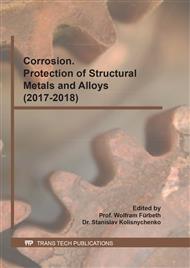[1]
J. He, Q.Z. Cai, H.H. Luo, Influence of silicon on growth process of plasma electrolytic oxidation coating on Al–Si alloy, J. Alloys Compd. 471 (2009) 395-399.
DOI: 10.1016/j.jallcom.2008.03.114
Google Scholar
[2]
A. Polat, M. Makaraci, M. Usta, Influence of sodium silicate concentration on structural and tribological properties of micro arc oxidation coatings on 2017A aluminum alloy substrate, J. Alloys Compd. 504 (2010) 519-526.
DOI: 10.1016/j.jallcom.2010.06.008
Google Scholar
[3]
I.J. Hwang, D.Y. Hwang, Y.M. Kim, et al, Formation of uniform passive oxide layers on high Si content Al alloy by plasma electrolytic oxidation, J. Alloys Compd. 504 (2010) 527–530.
DOI: 10.1016/j.jallcom.2010.02.074
Google Scholar
[4]
Sh.G. Xin, L.X. Song, R.G. Zhao, Properties of aluminium oxide coating on aluminium alloy produced by micro-arc oxidation, Surf. Coat. Technol. 199 (2005) 184-188.
DOI: 10.1016/j.surfcoat.2004.11.044
Google Scholar
[5]
L. Wen, Y.M. Wang, Y. Zhou, Corrosion evaluation of microarc oxidation coatings formed on 2024 aluminium alloy, Corros. Sci. 52 (2010) 2687-2696.
DOI: 10.1016/j.corsci.2010.04.022
Google Scholar
[6]
X. Nie, A. Leylan, H.W. Song, et al, Thickness effects on the mechanical properties of micro-arc discharge oxide coatings on aluminium alloys, Surf. Coat. Technol. 119 (1999) 1055-1060.
DOI: 10.1016/s0257-8972(99)00089-4
Google Scholar
[7]
W.J. Huang, D.M. Hua, H.F. Zhu, Effects of the ratio of anodic and cathodic currents on the characteristics of micro-arc oxidation ceramic coatings on Al alloys, App. Surf. Sci. 292 (2014) 658-664.
DOI: 10.1016/j.apsusc.2013.12.028
Google Scholar
[8]
M.A. Chen, Y.C. Ou, Y.H. Fu, et al, Effect of friction stirred Al-Fe-Si particles in 6061 aluminum alloy on structure and corrosion performance of MAO coating, Surf. Coat. Technol. 304 (2016) 85-97.
DOI: 10.1016/j.surfcoat.2016.07.003
Google Scholar
[9]
I. Shchedrina, A.G. Rakoch, G. Henrion, Non-destructive methods to control the properties of MAO coatings on the surface of 2024 aluminium alloy, Surf. Coat. Technol. 238 (2014) 27-44.
DOI: 10.1016/j.surfcoat.2013.10.032
Google Scholar
[10]
C.J. Hu, M.H. Hsieh, Preparation of ceramic coatings on an Al–Si alloy by the incorporation of ZrO2 particles in micro arc oxidation, Surf. Coat. Technol. 258 (2014) 275-283.
DOI: 10.1016/j.surfcoat.2014.09.012
Google Scholar
[11]
M. Mohedano, E. Matykina, R. Arrabal, et al, PEO of pre-anodized Al–Si alloys: Corrosion properties and influence of sealings, Appl. Surf. Sci. 346 (2015) 57-67.
DOI: 10.1016/j.apsusc.2015.03.206
Google Scholar
[12]
Y.M. Wang, H. Tian, X.E. Shen, et al, An elevated temperature infrared emissivity ceramic coating formed on 2024 aluminium alloy by microarc oxidation, Ceram. Int. 39 (2013) 2869 -2875.
DOI: 10.1016/j.ceramint.2012.09.060
Google Scholar
[13]
M.A. Chen, S.Y. Liu, J.M. Li, et all, Improvement to corrosion resistance of MAO coated 2519 aluminum alloy by formation of polypropylene film on its surface, Surf. Coat. Technol. 232 (2013) 674-679.
DOI: 10.1016/j.surfcoat.2013.06.073
Google Scholar
[14]
R.D. Armstrong, V.J. Braham, The mechanism of aluminum corrosion in alkaline solution, Corros. Sci. 38 (1996) 1463-1471.
Google Scholar



